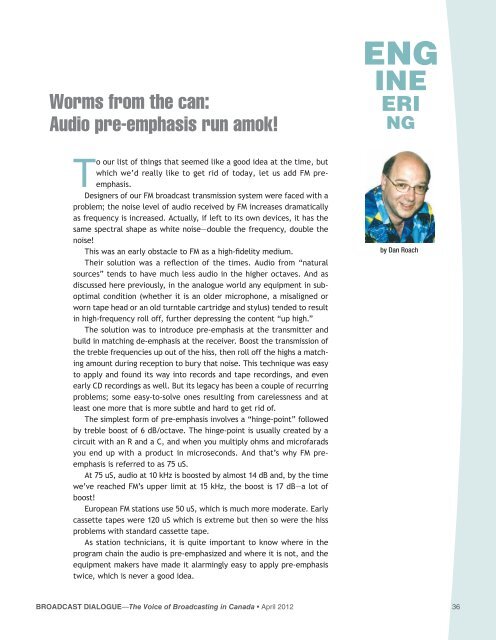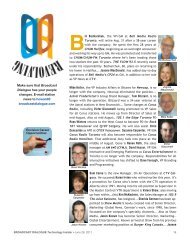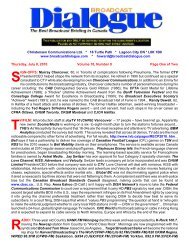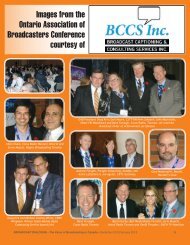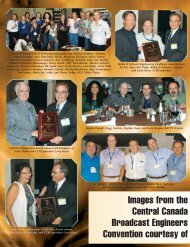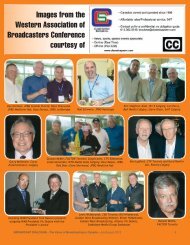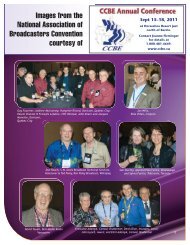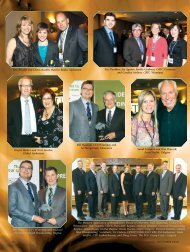Current PDF Edition - Broadcast Dialogue
Current PDF Edition - Broadcast Dialogue
Current PDF Edition - Broadcast Dialogue
You also want an ePaper? Increase the reach of your titles
YUMPU automatically turns print PDFs into web optimized ePapers that Google loves.
Worms from the can:<br />
Audio pre-emphasis run amok!<br />
T<br />
o our list of things that seemed like a good idea at the time, but<br />
which we’d really like to get rid of today, let us add FM preemphasis.<br />
Designers of our FM broadcast transmission system were faced with a<br />
problem; the noise level of audio received by FM increases dramatically<br />
as frequency is increased. Actually, if left to its own devices, it has the<br />
same spectral shape as white noise—double the frequency, double the<br />
noise!<br />
This was an early obstacle to FM as a high-fidelity medium.<br />
Their solution was a reflection of the times. Audio from “natural<br />
sources” tends to have much less audio in the higher octaves. And as<br />
discussed here previously, in the analogue world any equipment in suboptimal<br />
condition (whether it is an older microphone, a misaligned or<br />
worn tape head or an old turntable cartridge and stylus) tended to result<br />
in high-frequency roll off, further depressing the content “up high.”<br />
The solution was to introduce pre-emphasis at the transmitter and<br />
build in matching de-emphasis at the receiver. Boost the transmission of<br />
the treble frequencies up out of the hiss, then roll off the highs a matching<br />
amount during reception to bury that noise. This technique was easy<br />
to apply and found its way into records and tape recordings, and even<br />
early CD recordings as well. But its legacy has been a couple of recurring<br />
problems; some easy-to-solve ones resulting from carelessness and at<br />
least one more that is more subtle and hard to get rid of.<br />
The simplest form of pre-emphasis involves a “hinge-point” followed<br />
by treble boost of 6 dB/octave. The hinge-point is usually created by a<br />
circuit with an R and a C, and when you multiply ohms and microfarads<br />
you end up with a product in microseconds. And that’s why FM preemphasis<br />
is referred to as 75 uS.<br />
At 75 uS, audio at 10 kHz is boosted by almost 14 dB and, by the time<br />
we’ve reached FM’s upper limit at 15 kHz, the boost is 17 dB—a lot of<br />
boost!<br />
European FM stations use 50 uS, which is much more moderate. Early<br />
cassette tapes were 120 uS which is extreme but then so were the hiss<br />
problems with standard cassette tape.<br />
As station technicians, it is quite important to know where in the<br />
program chain the audio is pre-emphasized and where it is not, and the<br />
equipment makers have made it alarmingly easy to apply pre-emphasis<br />
twice, which is never a good idea.<br />
ENG<br />
INE<br />
ERI<br />
NG<br />
by Dan Roach<br />
BROADCAST DIALOGUE—The Voice of <strong>Broadcast</strong>ing in Canada • April 2012 36


